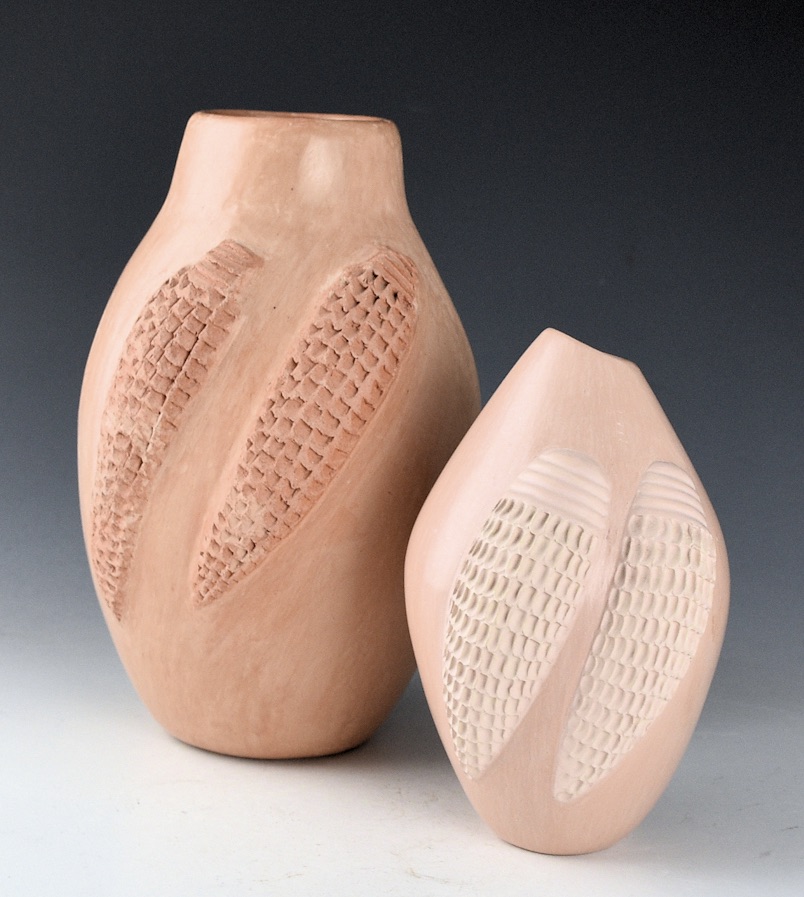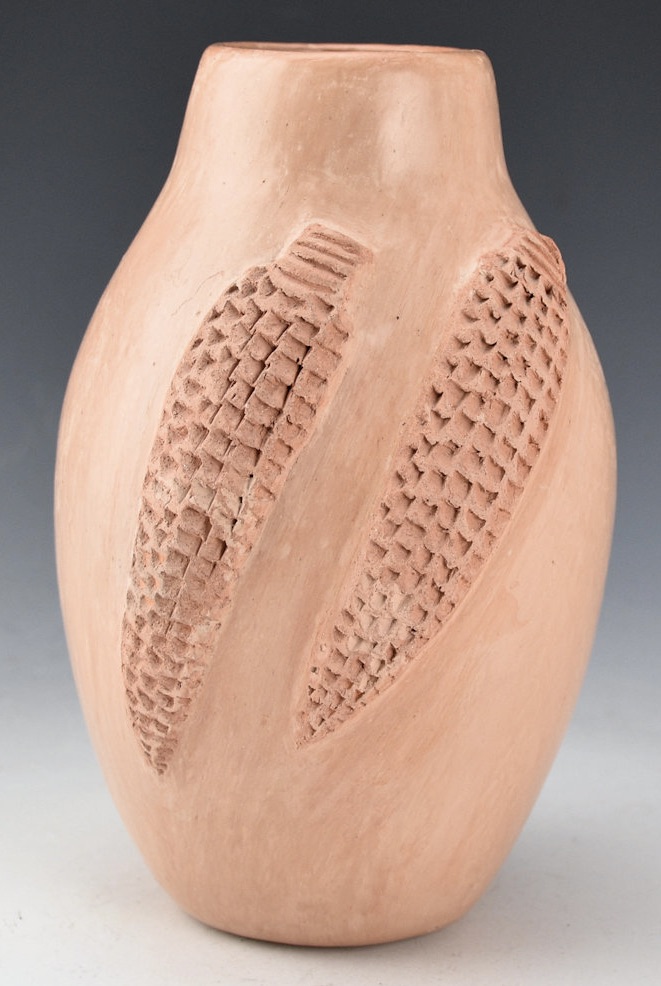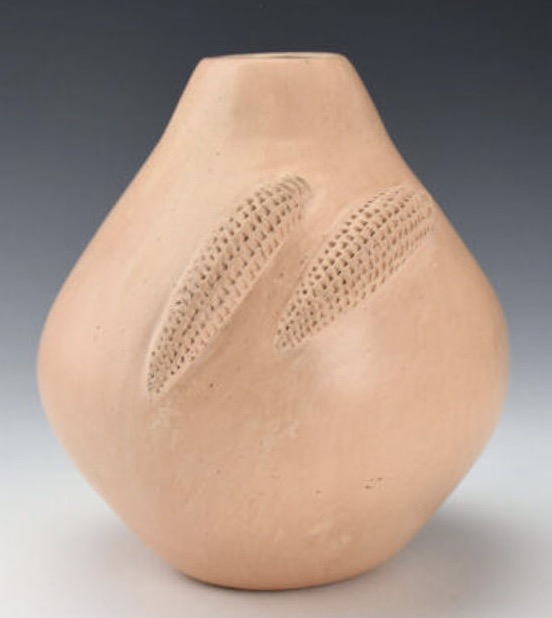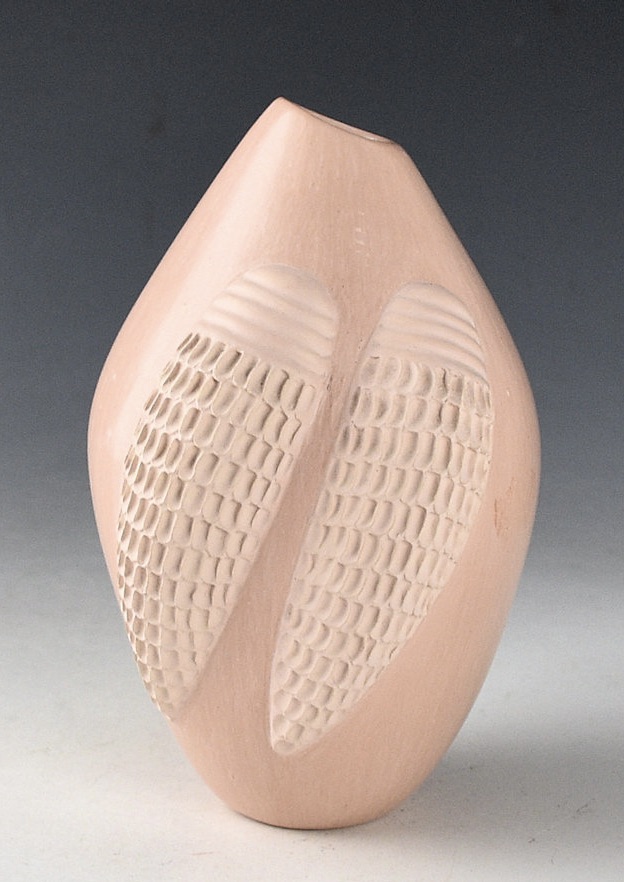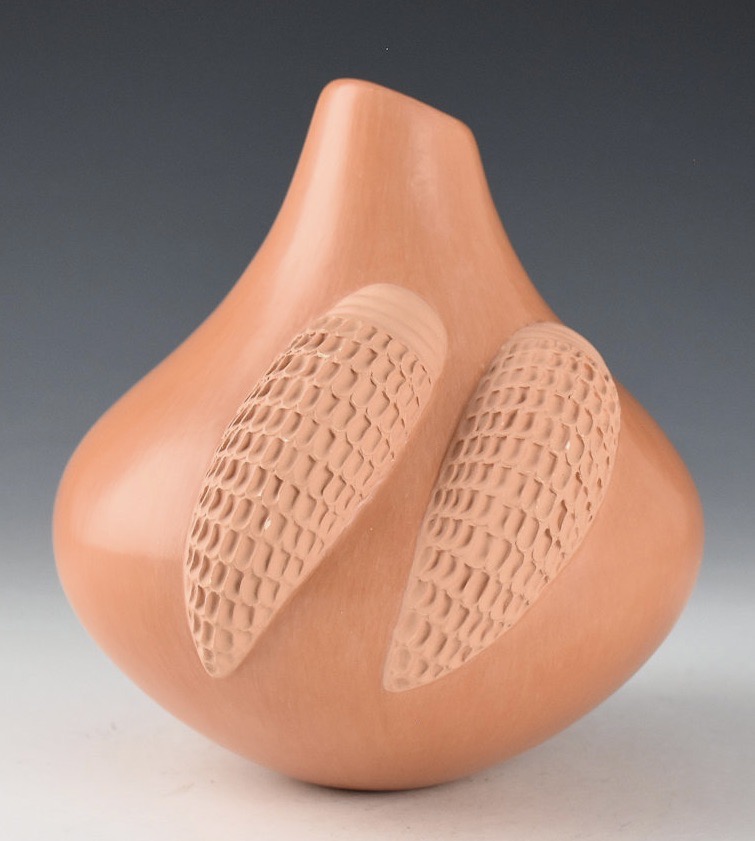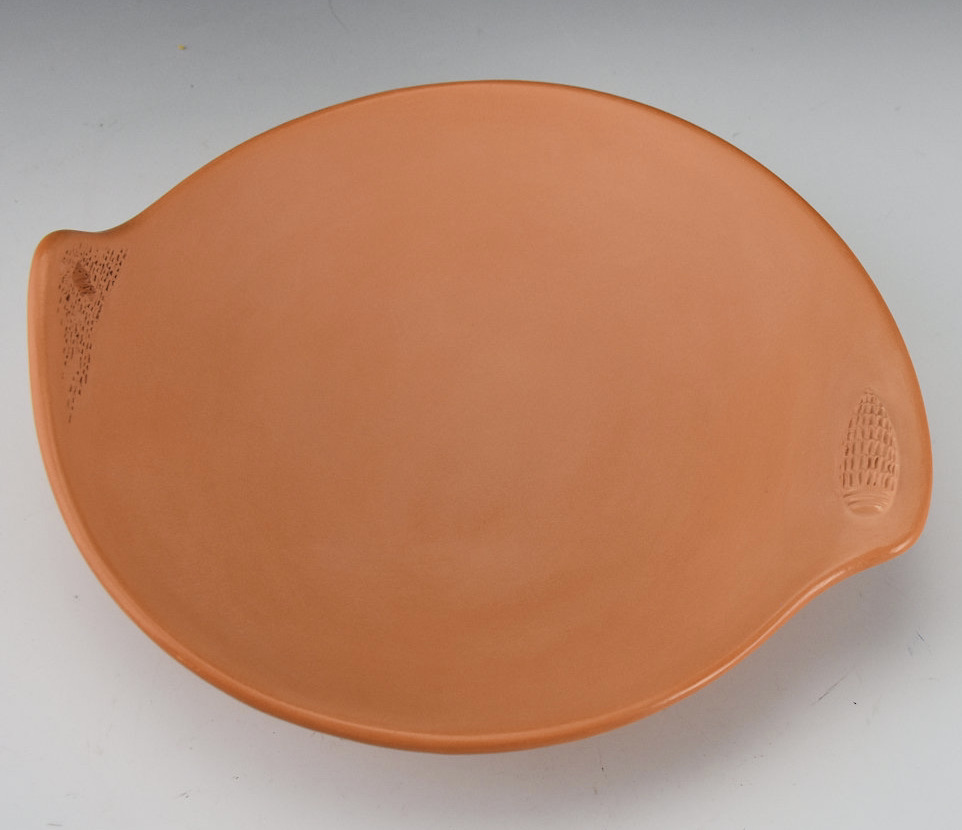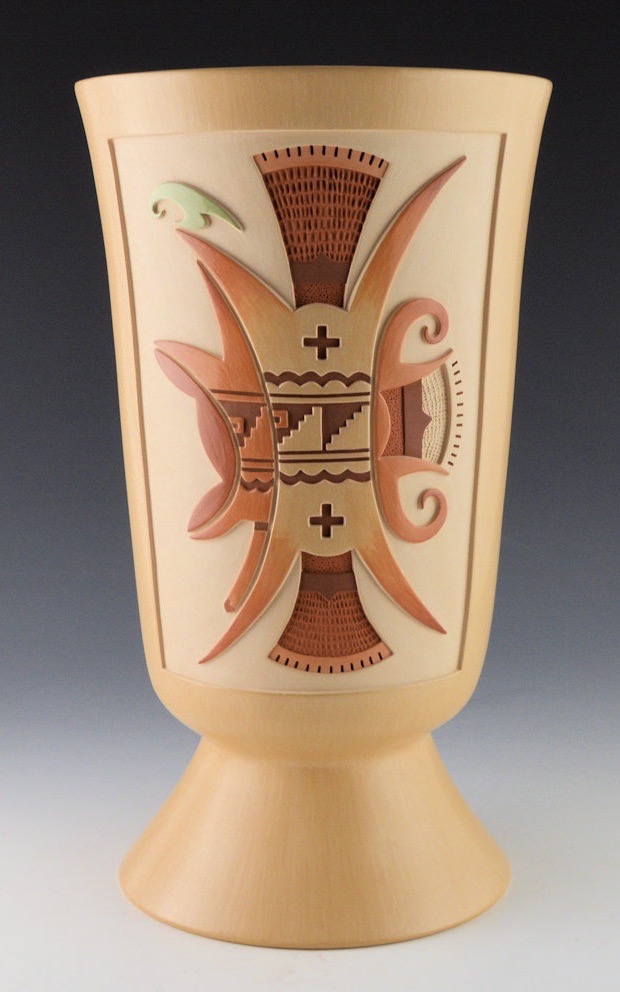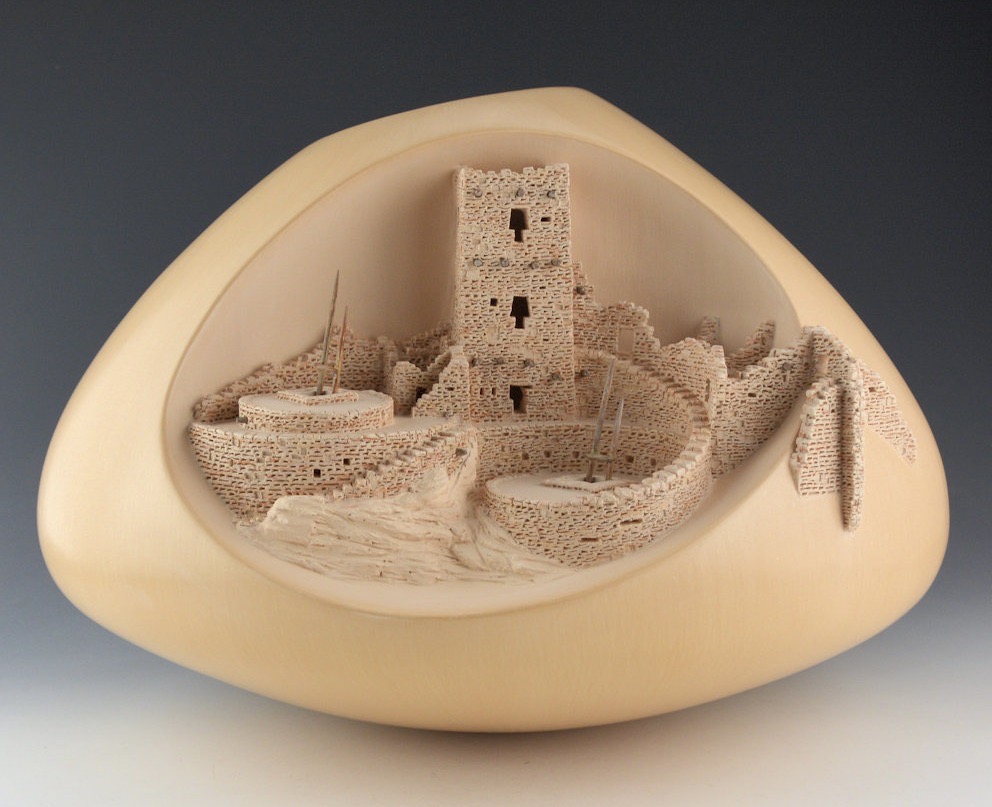Collector's Corner
FROM GENERATION TO GENERATION: The Ceramic Art of Elizabeth White and Al Qöyawayma
For most Pueblo ceramic artists, their family is their art school. They either learn directly from a relative or by closely examining the work of an ancestor. This was certainly true of Al Qöyawayma and his aunt Elizabeth White, also known as Polingaysi, her Hopi name. Al Q, as he is affectionately known, learned to make pottery from his aunt, including the technique of repoussé whereby clay is pushed out from the inside of a piece to create a design on the outside in raised relief.
Polingaysi Qöyawayma was born at Orabi on Third Mesa at Hopi in 1892. Her parents named her Polingaysi, which means “butterfly sitting among the flowers in the breeze.” When she later converted to Christianity, she changed her name to Elizabeth. In 1931, she married Lloyd White who was part Cherokee, but the marriage was very brief. Polingaysi became a school teacher and taught at Hopi and Navajo schools for almost forty years. It was only when she retired in 1954 that she began making pottery.
Double corn jar by Elizabeth White (“Polingaysi”), Hopi, 7.5”h (1981). Collection of E. J. Guarino. Image courtesy of King Galleries.
In 1975, Elizabeth White and Al Qöyawayma saw Ancient Ecuador, Culture, Clay, and Creativity at the Field Museum in Chicago and immediately realized that the technique they were using to create a corn motif in their Hopi ceramics dated as far back as 1900 B.C. The corn motif is considered sacred and is used as a sign of respect towards corn, which has sustained Native People for many generations.
Mauve jar with double corn motif by Elizabeth White, Hopi, 4.5”w x 5.5”h (circa 1970s). Private collection. Image courtesy of King Galleries.
Elizabeth White was not prolific. She made very few ceramic works because she started her pottery career late in life. She did, however, discover a unique clay, which she felt needed no painted decoration. Because of this, White decided to create unembellished pots, only occasionally adding a repoussé element such as two ears of corn or Pueblo figures. Her classic jars with two ears of corn are stone polished to a high sheen except for the repoussé corn which is unpolished matte. Though rare, her pottery is sought after by collectors. Her work, which appears utilitarian, is elegant in its simplicity, employing traditional forms and the various colors of Hopi clay.
Mauve colored jar with asymmetric rim and double corn design by Al Qöyawayma, Hopi, 3.5”w x 6”h (1976). Collection of E. J. Guarino. Image courtesy of King Galleries.
Elizabeth White’s artistry lives on through the creations of her nephew Al Qöyawayma whose ceramic work raises the style of her unpainted Hopi vessels to new levels of sophistication. Al Qöyawayma creates vessels that pay homage to his aunt but he also produces others that incorporate sculptural elements and repoussé as well as those that are polychrome. Al Qöyawayma wrote the following about his beloved aunt: “Through the gentle hand and guidance of a beautiful teacher, my aunt Polingaysi, I learned the basic techniques and philosophy I now use in my pottery creations.” Elizabeth (Polingaysi) White died in 1990.
Asymmetric Jar with Double Corn Design by Al Qöyawayma, Hopi, 5″w x 5.75”h (1980). Image courtesy of King Galleries.
There is an elegance and refinement in the work of Al Qöyawayma, which is immediately recognizable. The viewer need not know anything about this artist’s work to perceive its sophistication. It is something that is immediately recognizable to ones eyes. Al Qöyawayma is among a rarified group of Pueblo ceramic artists who have raised pottery making from the level of craft to that of art. Perhaps the exquisite design of his ceramics can be attributed to a combination of his training as a mechanical engineer and his Hopi culture.
Open bowl with Corn and Pueblo designs by Al Qöyawayma, Hopi, 8″w x 2.75”h (2021). The interior is matte and the outside is stone polished. Collection of E. J. Guarino. Image courtesy of King Galleries.
Although a number of motifs appear in Qöyawayma’s work, corn is one of the most important. Like his aunt, he has decorated many of his pieces with images of corn created with the repoussé technique. The shape is pushed from inside the vessel and then worked on the outside to create the appearance of kernels. For the Hopi, corn is used in religious ceremonies as a prayer offering. It symbolizes sustenance, fertility, life, and surviving in a difficult environment. Considered a sentient being, it is referred to as Corn Mother.
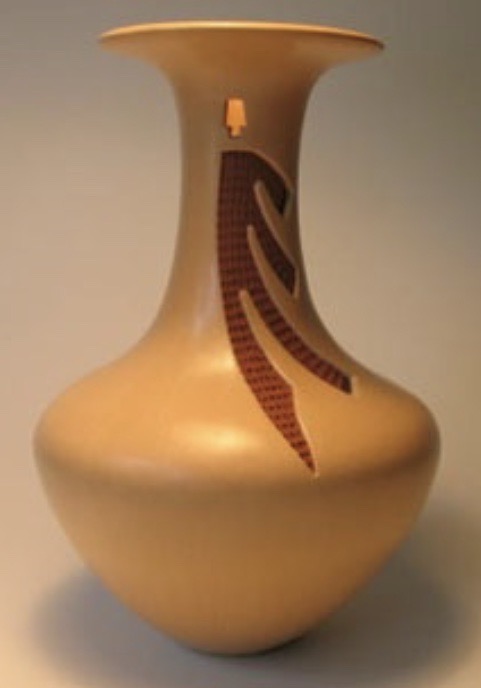 |
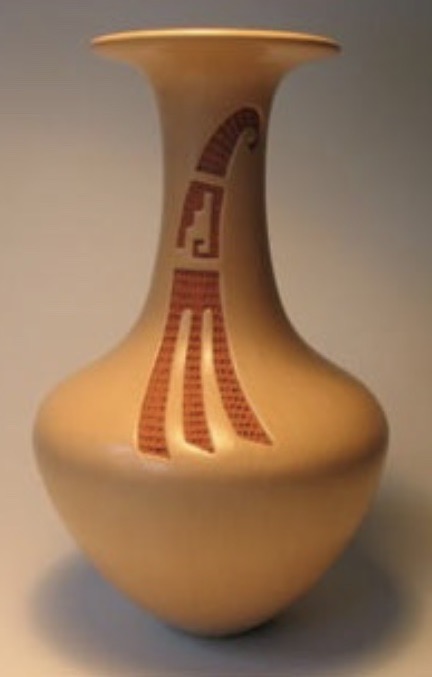 |
Harmony Vase by Al Qöyawayma, Hopi, carved Hopi designs on both sides and cut out in the form of an Ancestral Puebloan doorway on one side of the stem, 7”h x 4 1/8” w (1996). Collection of E. J. Guarino.
Al Qöyawayma’s Harmony Vase can be read on multiple levels. Both sides of the vase are in balance. Carved Hopi designs decorate both sides of the vessel, creating a wonderful sense of symmetry. On one side of the vase there is a cutout of an Ancestral Puebloan doorway high on the vase’s neck. The work’s title, Harmony Vase, may also be an allusion to the Hopi belief that humans must live in peace and harmony with nature, a concept which permeates every aspect of Hopi culture. Not doing so results in koyaanisqatsi, a “life of moral corruption and chaos,” or “life out of balance”. Harmony and balance epitomize Al Qöyawayma’s art.
Kiva Pept, large polychrome jar by Al Qöyawayma, Hopi, 7.5″w x 13”h (2022). Image courtesy of King Galleries.
Although there are notable exceptions, Hopi pottery is generally coveted for its refined form and precisely painted polychrome patterns. In creating Kiva Pept, Al Qöyawayma imagined the course of Hopi pottery making if there had been no contact with European culture. In visualizing such a piece, he carved shapes into the body and painted it in the soft tones that collectors have come to associate with Sikyátki and Sikyátki Revival ceramics – cream, burnt orange, brown, and tan. One exception is the small area on the left side of the piece, which is painted light green. Interestingly, the jar is evocative of Mesoamerican ceramic incense burners.
Mesa Verde Architectural Jar with Spiral Staircase by Al Qöyawayma, Hopi, 14″w x 10”h (2023). Image courtesy of King Galleries.
The works that comprise Al Qöyawayma’s Mesa Verda Series are nothing less than spectacular. These creations are masterpieces of ceramic art, leaving the viewer to wonder in astonishment at how they were fashioned. Combining pottery making, sculpture, mathematical precision, and sheer artistic and technical wizardry, they are unique.
Qöyawayma’s Mesa Verde Architectural Jar with Spiral Staircase is nothing less than astonishing. Th concave oval area of the piece was pushed into the clay and, then, using the repoussé technique, the buildings were pushed out from the inside of the bowl. The oblong space is filled with multiple buildings based on those found at Mesa Verde, an Ancestral Puebloan archaeological site in Colorado. The scene is dominated by a large, square tower located in the background. The tower’s facade uses three iconic Ancestral Puebloan doors as windows. Next to this tower are the ruins of another tower. In front of the tower are two kivas, underground ceremonial spaces. Both have wooden ladders, which were added after firing. There are also ruins of five other buildings. Two other striking aspects of the piece are a spiraling stairway, which carries the viewer’s eye from background to foreground, and a wall that appears to emerge from the framing device of the oval. Al Qöyawayma’s Mesa Verde Architectural Jar with Spiral Staircase is a technical and artistic tour de force.
About his art Al Qöyawayma wrote, “Form, textures, contrasts, shadow, and the softness of desert color hues are foremost in my work. Oral history and research provide me with emerging themes; identifying who we are is a profound pursuit. At the same time, my repoussé technique offers a ‘contemporary’ style of ceramics. A particular tradition does not restrict me; I’m free to innovate.”
Double corn jar by Elizabeth White (“Polingaysi”) and mauve colored jar with asymmetric rim and double corn design by Al Qöyawayma. Collection of E. J. Guarino.
The influence of Elizabeth (Polingaysi) White on Al Qöyawayma’s art is undeniable. Absorbing the technical lessons of his aunt, Al Qöyawayma experimented and innovated, creating stunning ceramic works that reflect his Hopi culture. Both artists were dedicated to the art of pottery making. One of the hallmarks of their ceramics is their use of repoussé. Like his aunt, Al Qöyawayma used the technique to create corn imagery on his pottery vessels, but he took the skill further, fashioning low-relief dancing figures, animals, feathers, and ancient architecture on his ceramic works. Under the tutelage of his aunt, Al Qöyawayma developed a style that, though influenced by ancient Sikyátki ceramics, is complex, thin, and minimalist in form.


